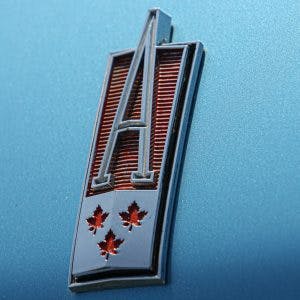Media | Articles
10 Canadian car names from back in the day
Over the years, Canada has had its fair share of unique models. You may be peripherally familiar with some of the exclusive machines that came from north of the border: Pontiacs powered by Chevrolet engines, Plymouth-Dodges (a.k.a. “Plodges”), and a dizzying array of Ford derivatives. Canadian tariffs (solved by the 1965 Auto Pact trade agreement) and other business conditions were often the driving force behind these nation-specific vehicles. This intriguing niche of cars often included names with cultural connections, often inspired by national pride in Canadian history or geography.
Parisienne
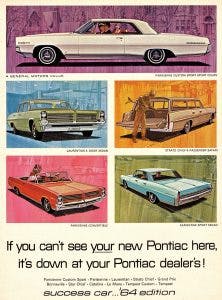
This model, whose name refers to a female from Paris, is perhaps the most recognizable model outside of Canada. From 1983–86, the Parisienne was available in American showrooms as a quick-fix fill-in once Pontiac made the gaffe of discontinuing the full-size Bonneville.
For Canadians, however, the Parisienne—a stylish model akin to an Impala with Bonneville styling—originated as a sub-model of the 1958 Laurentian. Like the Impala (and Bonneville, for that matter), the Parisienne was mainstreamed into the Canadian Pontiac lineup in 1959, eventually joined by Grand Parisienne and Parisienne 2+2 variants in the mid-1960s.
In 1982, the Parisienne became a Chevrolet Caprice with its own unique grille; that was the car that would appear in the U.S. a year later.
Laurentian
Another full-size Pontiac, the Laurentian debuted in 1953 as the new top trim level, until the Parisienne appeared. After that, the Laurentian sat solidly in the middle through 1978. The name derives from the Laurentian Highlands in Quebec, an area situated between the Saint Lawrence River and Hudson Bay.
Marketplace
Buy and sell classics with confidence
Acadian
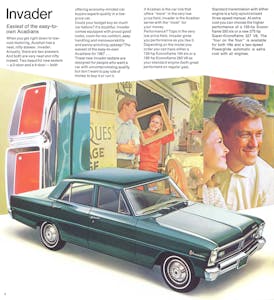
Introduced in 1962 as a new brand (not model) sold by Pontiac dealerships, the Acadian was basically a Chevy II with Pontiac-influenced styling. Starting in 1968, the redesigned Acadian featured looks that differed little from the American Nova; a new 350-powered SS model was as exciting as it got through 1971, at which point the Pontiac Ventura replaced the marque. The name was revived in 1980 for a Canadian-market Pontiac based on the Chevrolet Chevette.
Both the marque and model were named after the group of people of southwestern French origin that descended from the colony of Acadia, whose territory includes part of present-day Quebec, Nova Scotia, New Brunswick, Prince Edward Island, and Maine.
Canso
A trim level for the Acadian through 1967, the Canso name derives from a community in Nova Scotia that was established in 1604. The settlement played a strong role in Canadian history as an early center for fishing and fur trading.
Beaumont
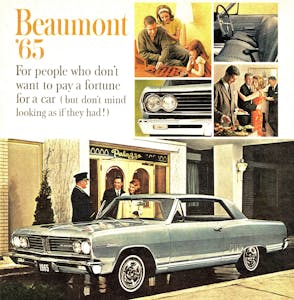
What started out as an Acadian trim level for 1962–63 became its own marque for 1964, evolving into somewhat of a half-brother to the Chevrolet Chevelle. The most distinctive of the Pontiac bunch (although, remember, not branded as a Pontiac), the Beaumont was produced through 1969. There is no clear Canadian lineage of the name, but it’s possible it was inspired by a village in Quebec.
Frontenac
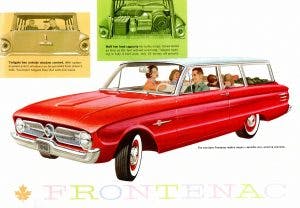
The Falcon-based Frontenac is yet another example of a Canadian vehicle marketed as a stand-alone brand. It was only produced for 1960 and sold by Mercury-Meteor dealerships before Ford of Canada decided to replace it with the Mercury Comet. While the Falcon was conventional in its styling, the Frontenac’s nose was quite the opposite. It was named after a soldier and governor of New France: Louis de Buade de Frontenac.
Montcalm
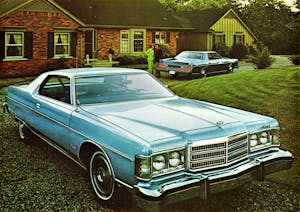
For 1949, Ford of Canada debuted the Meteor brand to sell Mercury-trimmed Fords at Mercury dealerships. Several years later, Meteor developed more far-out styling. The introduction of the American Mercury Meteor caused a brief hiatus after 1961, but the Meteor brand returned for 1964–76 as a full-size Mercury with slightly tweaked styling.
Montcalm was a stalwart presence in the Meteor lineup from mid-year 1959 (mimicking the Galaxie’s roofline) through ’76, with some years featuring a sporty S33 variant. The name is derived from Louis-Joseph de Montcalm, who was a commander during the Seven Years’ War.
Rideau
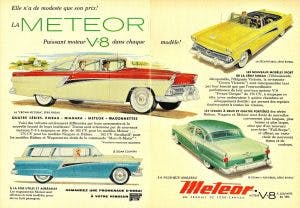
A top Meteor model that first appeared in 1954, the Rideau was eventually joined by the Rideau 500 and then pushed down the totem pole by the Montcalm’s arrival in ’59. The word rideau means “curtain” in French; the Rideau Canal is a tributary that connects the Canadian capital of Ottawa to Lake Ontario and the Saint Lawrence River.
LeMoyne
This was the top Meteor trim level for 1968–70, named after Charles le Moyne de Longueuil et de Châteauguay, a New France settler.
Richelieu
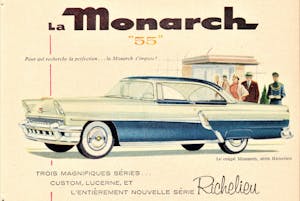
If you are by this point struggling to grasp exactly where Meteor fit within the larger Ford of Canada product strategy, then you’ll really be confused to learn that Ford of Canada had another market-specific brand, called Monarch. The first Monarchs to hit Canadian Ford dealerships arrived in 1946 and used Mercury bodies with different trim. This trend continued through 1957, at which point which the introduction of the Edsel took priority and Monarch was set aside. Alas, poor Edsel sales pushed Ford to revive the Monarch brand for 1959, but it was again discontinued after 1961, by which point its critics deemed it a purveyor of gaudy Mercurys. The Richelieu trim level was available from 1955–61 and took its name from a tributary in the Saint Lawrence River honoring a famous 17th-century French cardinal.
And what about the Mopars?

Just as General Motors and Ford Motor Company did, Chrysler Corporation handled its Canadian fare in its own special way. While the names never veered in the direction of patriotism or national heritage, the Canadian market often called upon models that were no longer used in Detroit (1962–66 Chrysler Windsor, 1965 Plymouth Savoy, and the hybrid 1965–66 Polara 440 and 880) or those that were distinct from nameplates used in the U.S.
Perfect examples of the latter strategy: Dodge Crusader, Regent, and Mayfair, all of which were trim levels for Canadian Dodges built in various years throughout the 1950s. They were not quite true Dodges, however, as the cars were essentially Plymouths with Dodge front ends; the 1963–64 Plymouth Valiant also was similar in that it was a Dodge Dart with a Valiant nose.
